
Eucalyptus pauciflora, commonly known as snow gum, cabbage gum or white sally, is a species of tree or mallee that is native to eastern Australia. It has smooth bark, lance-shaped to elliptical leaves, flower buds in clusters of between seven and fifteen, white flowers and cup-shaped, conical or hemispherical fruit. It is widespread and locally common in woodland in cold sites above 700 m (2,300 ft) altitude.
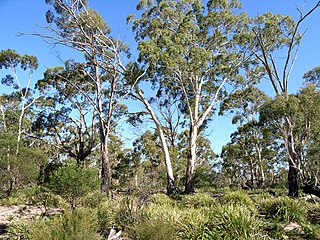
Eucalyptus viminalis, commonly known as the manna gum, white gum or ribbon gum, is a species of small to very tall tree that is endemic to south-eastern Australia. It has smooth bark, sometimes with rough bark near the base, lance-shaped to curved adult leaves, flower buds in groups of three or seven, white flowers and cup-shaped or hemispherical fruit.

Eucalyptus macrorhyncha, commonly known as the red stringybark, is a species of medium-sized tree that is endemic to eastern Australia. It has rough, stringy, grey to brown bark, lance-shaped adult leaves, flower buds in groups of between seven and eleven, white flowers and hemispherical fruit.
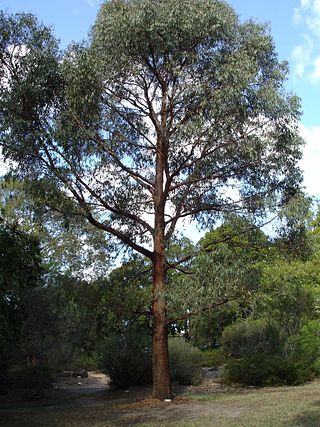
Eucalyptus radiata, commonly known as the narrow-leaved peppermint or Forth River peppermint, is a species of tree that is endemic to south-eastern Australia. It has rough, fibrous to flaky bark on the trunk and larger branches, smooth grey bark on the thinner branches, lance-shaped to curved or almost linear leaves, flower buds in groups of eleven to twenty or more, white flowers and cup-shaped, hemispherical or shortened spherical fruit.
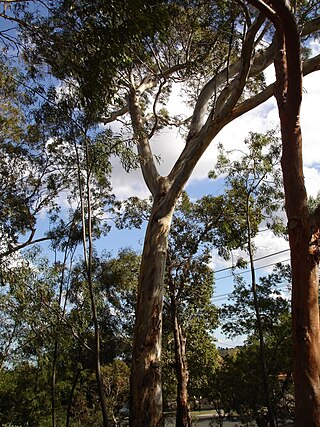
Eucalyptus leucoxylon, commonly known as yellow gum, blue gum or white ironbark, is a species of small to medium-sized tree that is endemic to south-eastern continental Australia. It has smooth yellowish bark with some rough bark near the base, lance-shaped or curved adult leaves, flower buds in groups of three and cylindrical, barrel-shaped or shortened spherical fruit. A widely cultivated species, it has white, red or pink flowers.
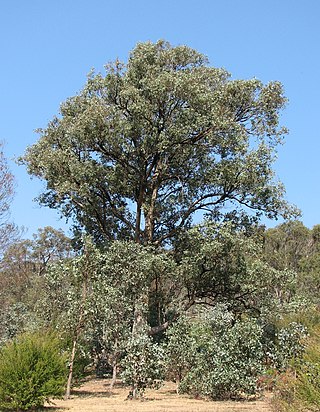
Eucalyptus polyanthemos, commonly known as red box, is a species of small to medium-sized tree, that is native to eastern Australia but has been introduced into other countries. It has fibrous bark on the trunk and larger branches, smooth greyish to cream-coloured bark above, or smooth bark throughout. It has broadly egg-shaped to round juvenile leaves, lance-shaped, egg-shaped or almost round adult leaves, flower buds in groups of seven, white flowers and barrel-shaped to conical fruit.
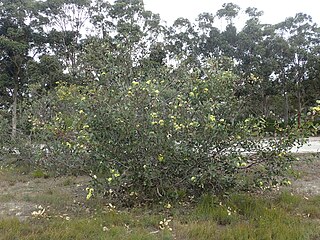
Eucalyptus preissiana, commonly known as bell-fruited mallee, is a species of small tree or shrub that occurs in an area between Albany and Esperance in Western Australia. It has a spreading habit, smooth bark, elliptical to egg-shaped or oblong leaves, flower buds in groups of three, yellow flowers and cup-shaped, conical or bell-shaped fruit.

Eucalyptus globulus subsp. bicostata, commonly known as the southern blue gum, eurabbie, blue gum or Victorian blue gum, is a subspecies of tree that is endemic to south-eastern Australia. It has mostly smooth bark with some persistent slabs of old bark at the base, juvenile leaves with one glaucous side, glossy, lance-shaped adult leaves, warty flower buds in groups of three, white flowers and hemispherical to conical fruit.

Eucalyptus globulus subsp. maidenii, commonly known as Maiden's gum, is a subspecies of tree that is endemic to southeastern Australia. It has mostly smooth bark with some persistent slabs of old bark at the base, juvenile leaves with one glaucous side, lance-shaped adult leaves, flower buds arranged in groups of seven, white flowers and conical, pedicellate, sometimes glaucous fruit that is more or less square in cross-section

Eucalyptus globulus subsp. pseudoglobulus, commonly known as Victorian eurabbie, is one of the four subspecies of Eucalyptus globulus and is endemic to southeastern Australia. It has mostly smooth bark with some persistent slabs of old bark at the base, juvenile leaves with one glaucous side, glossy, lance-shaped adult leaves, pedicellate flower buds in groups of three, white flowers and conical fruit.

Eucalyptus camphora, commonly known as swamp gum is a flowering plant that is endemic to south-eastern Australia. It is a species of small to medium-sized tree with smooth bark, sometimes rough at the base, broadly lance-shaped to egg-shaped or elliptic adult leaves, flower buds in groups of seven, white flowers and conical fruit. There are two subspecies, subspecies camphora, commonly known as broad-leaved sally or swamp gum and subspecies humeana, commonly known as mountain swamp gum.

Eucalyptus mannifera, commonly known as the brittle gum or red spotted gum, is a species of small to medium-sized tree that is endemic to south-eastern Australia. It has smooth, powdery white bark, lance-shaped to curved adult leaves, flower buds in groups of seven, white flowers and cup-shaped, hemispherical or conical fruit.

Eucalyptus phenax, commonly known as green dumosa mallee or white mallee, is a species of mallee that is endemic to southern Australia. It has smooth bark, lance-shaped adult leaves, flower buds in groups of seven or nine, white flowers and cup-shaped to cylindrical fruit.

Eucalyptus crucis is a species of mallee that is endemic to Western Australia. There are three subspecies, commonly known as silver mallee or Southern Cross mallee,, narrow-leaved silver mallee, and Paynes Find mallee,. It has rough bark that is shed in curling flakes, more or less round, glaucous juvenile leaves, egg-shaped intermediate leaves and lance-shaped adult leaves. The type of bark and the proportion of juvenile, intermediate and adult leaves in the crown of mature plants varies with subspecies. The flower buds are arranged in groups of seven in leaf axils, the flowers are whitish to pale yellow and the fruit is a conical to hemispherical capsule.
Eucalyptus pauciflora subsp. acerina, commonly known as snow gum, is a mallee or small tree that is endemic to a small area of Victoria, Australia. It has smooth, shiny bark, glossy green lance-shaped to egg-shaped leaves, flower buds in groups of between nine and fifteen, white flowers and hemispherical or conical fruit. It differs from other subspecies of E. pauciflora in having a dense crown and no parts that are glaucous.
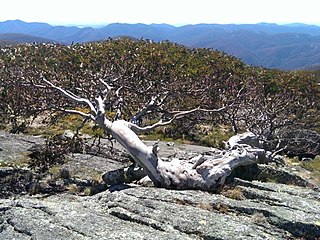
Eucalyptus pauciflora subsp. debeuzevillei, commonly known as Jounama snow gum, is a mallee or small tree that is native to a few mountain peaks in south-eastern Australia. It has smooth, shiny bark, glossy green lance-shaped to egg-shaped leaves, flower buds in groups of between nine and fifteen, white flowers and hemispherical or conical fruit. It differs from other subspecies of E. pauciflora in having angular flower buds.
Eucalyptus pauciflora subsp. hedraia, commonly known as snow gum, is a mallee or small tree that is endemic to a small area of Victoria, Australia. It has smooth bark, branchlets that are often glaucous, glossy green lance-shaped to egg-shaped or elliptical adult leaves, flower buds in groups of between eleven and fifteen, white flowers and hemispherical or cup-shaped fruit. It differs from other subspecies of E. pauciflora in having larger, sessile, glaucous buds and broader, hemispherical fruit.
Eucalyptus pauciflora subsp. parvifructa is a mallee or small tree that is endemic to a small area of Victoria, Australia. It has smooth bark, slightly glaucous branchlets, glossy green, lance-shaped adult leaves, flower buds usually in groups of seven, white flowers and hemispherical or cup-shaped fruit. It differs from other subspecies of E. pauciflora in having a smaller habit and smaller leaves, flower buds and fruit.

Eucalyptus pauciflora subsp. niphophila, commonly known as snow gum, is a small tree or large shrub that is native to a few mountain peaks in eastern Australia. It has smooth bark, glossy green, lance-shaped to egg-shaped or elliptical leaves, flower buds in groups of between nine and fifteen, white flowers and cup-shaped, hemispherical or conical fruit. It differs from other subspecies of E. pauciflora in having more delicate, pedicellate flower buds and smaller leaves.

Eucalyptus pauciflora subsp. pauciflora, commonly known as snow gum, cabbage gum or white sally is a tree or mallee that is endemic to eastern Australia. It has smooth bark, glossy green, lance-shaped, curved or elliptical leaves, flower buds in groups of between nine and fifteen, white flowers and cup-shaped, hemispherical or conical fruit.




















